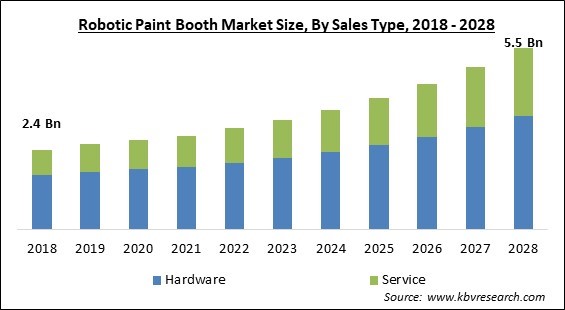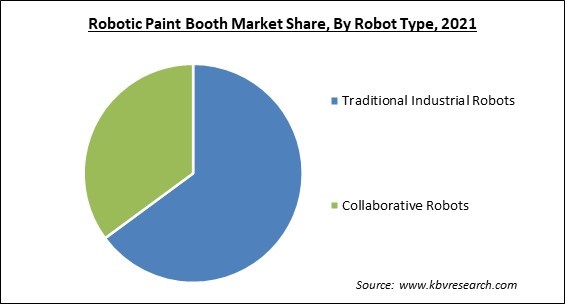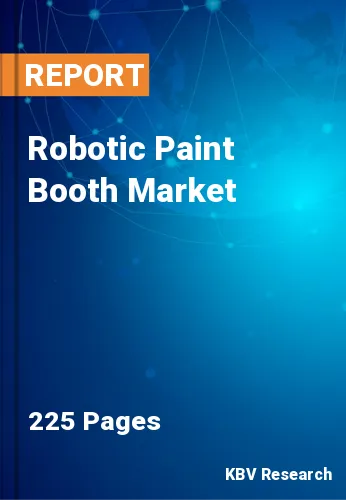The Global Robotic Paint Booth Market size is expected to reach $5.5 billion by 2028, rising at a market growth of 10.2% CAGR during the forecast period.
A robotic paint booth is a mechanical tool that applies primer, base, clear, and top coat among other painting tasks. Water, solvents, and powder-based products are also sprayed with it. Complex pieces, curves, indentations, and shapes of all sizes can be effectively covered by the spray booth. Robots that have been efficiently programmed can quickly and accurately produce surfaces with the best quality while applying complex spray designs with varying layer thicknesses.

Robotic paint booths employ the least amount of paint possible, increasing the manufacturing plant's cost-effectiveness. Robotic paint booths can meet the increasing demand for such booths due to the industry's shift toward precise manufacturing because they run continuously in time with the production line's speed. The robotic painting booth's spraying nozzles can evenly and efficiently apply paint to curved and complicated sections as well as flat surfaces. As a result, the robotic paint booth is a crucial part of the automotive, aerospace, and defense industries. Additionally, the demand for robotic paint booths is anticipated to rise due to the increased use of robotics and the adoption of automated production technology in various industries.
Every machine, from a small cog to a massive spacecraft, needs a coat of paint. Robot technologies are increasingly being used by manufacturers to meet their needs for painting and finishing. Robots are a relentless workforce that effectively delivers things with the best possible finishing with speed and accuracy, while also lowering operational expenses and waste production. The robots that are currently available are quite adaptable for end users and may be installed with simplicity using an easy-to-use application.
A robotic paint booth is a machine that works automatically to paint, spray, and coat objects for both automotive and non-automotive uses. Additionally, it sprays different film thicknesses of water, solvent, and powder-based substance. It is typically constructed with robot arms that are explosion-proof, allowing it to safely spray coverings without causing much damage to operators. Due to its capacity to paint several products in the shortest amount of time while producing less waste and exposing fewer people to dangerous chemicals, end users are choosing paint booths.
The expansion of the robotic paint booth market is aided by the automobile industry's recovery and the loosening of social restrictions as well as rising vaccination campaigns. The Covid-19 pandemic significantly altered the environment for many different enterprises and industries. The manufacturing sector was severely impacted by the import-export prohibition on non-essential goods and a labor shortage. Therefore, it is crucial to comprehend how the pandemic would impact the Robotic Paint Booth market as a whole in the years to come. The Covid-19 research helps the leading companies in the sector development plans for gaining an advantage over rivals.
Numerous industries, including those in the automobile, building, aerospace, and aviation, among others, employ robotic paints. As a result, the leading businesses in this market have established their production facilities in several areas, particularly in nations like India, Malaysia, Mexico, and other nations. One of the main factors propelling the market's expansion is the increasing use of robotics and the deployment of automated manufacturing technology across a variety of sectors. This machinery reduces the possibility of errors while speeding up and saving money on the whole process.

To increase the use of robotic paints and employ human labor for industrial operations as little as possible, the top firms in the robotic paint booth market are concentrating on the growing acceptance of cutting-edge technologies in the equipment sector. Key corporations are now competing more fiercely against one another, allowing them to grow their operations and expand their market share. Equipment designed to provide precise mixing and spraying can enhance quality, decrease waste and VOCs, and boost production overall. The robotics sector is fast driving the robotic paint booth market trends as a result of the growing technological convergence in artificial intelligence, automation, engineering, and machine learning.
It is a challenging undertaking to integrate robot arms and other hardware equipment gave the state of industrial development today. If the end user lacks the necessary engineering knowledge, a qualified system integrator would be needed. When assessing the viability of automation requirements, accuracy and cycle time would be given top importance. The anticipated production cycle can be used to assess production capacity and calculate return on investment, and enough accuracy can guarantee that each stage is performed correctly (ROI). When a target is located using vision, several factors, such as picture quality, placement algorithm, hand-eye relationship adjustment errors, camera lens correction errors, arm repeating accuracy, absolute accuracy, and so on, have an impact on the accuracy rate.
Based on Type, the Robotic Paint Booth Market is divided into 4 Axis, 6 Axis, and Others. The 4 Axis segment witnessed a significant revenue share in the robotic paint booth market in 2021. A more traditional arm, with the face plate, always parallel to the ground, is frequently used in palletizing applications. Allows the object it is choosing to be rotated. These typically take the shape of two adjacent linear guides and a third axis guide or cylinder in an XYZ configuration.
Based on the Sales Type, the Robotic Paint Booth Market is segmented into Hardware and services. The hardware segment procured the largest revenue share in the robotic paint booth market in 2021. An isolated paint transfer line connects a paint canister on the interior of a painting robot's outer arm to a non-conductive housing mounted with a color changer on the outside. A quick detach coupling securely fastens the paint canister to a piston ram and driving motor.
By Robot type, the Robotic Paint Booth Market is bifurcated into Traditional industrial robots and collaborative robots. The traditional industrial robots segment garnered the highest revenue share in the robotic paint booth market in 2021. It is because industrial robots are often massive, stationary pieces of machinery intended for exceptionally fast production speeds, enormous volume, and high accuracy. Industrial robots typically require safety precautions like a fence to keep humans out of the robot's work envelope because of the speed at which the robot's arm can move.
On the basis of the Industry, the Robotic Paint Booth Market is classified into Automotive, Aviation, and Others. The Aviation segment witnesses a substantial revenue share in the robotic paint booth market in 2021. The finish is crucial in both the aviation & automotive sectors. For performance and safety reasons, these pieces need to meet very exact requirements. Coatings can offer radar evasion, anti-static dissipation, and even erosion resistance. This is why maintaining continuity requires a uniform finish on all sections.
| Report Attribute | Details |
|---|---|
| Market size value in 2021 | USD 2.8 Billion |
| Market size forecast in 2028 | USD 5.5 Billion |
| Base Year | 2021 |
| Historical Period | 2018 to 2020 |
| Forecast Period | 2022 to 2028 |
| Revenue Growth Rate | CAGR of 10.2% from 2022 to 2028 |
| Number of Pages | 225 |
| Number of Tables | 420 |
| Report coverage | Market Trends, Revenue Estimation and Forecast, Segmentation Analysis, Regional and Country Breakdown, Companies Strategic Developments, Company Profiling |
| Segments covered | Sales Type, Type, Robot Type, Industry, Region |
| Country scope | US, Canada, Mexico, Germany, UK, France, Russia, Spain, Italy, China, Japan, India, South Korea, Singapore, Malaysia, Brazil, Argentina, UAE, Saudi Arabia, South Africa, Nigeria |
| Growth Drivers |
|
| Restraints |
|
Region-wise, the Robotic Paint Booth Market is analyzed across North America, Europe, Asia Pacific, and LAMEA. The Asia Pacific region procured the highest revenue share in the robotic paint booth market in 2021. Due to the strong development in vehicle sales and greater use of automation technology for painting or covering vehicle bodies, which is shortening the painting process and enhancing the plant's production activity. The automotive robotic painting market is expected to expand at an increasing rate in China and India due to the rising demand for vehicle customization in terms of design and color.
Free Valuable Insights: Global Robotic Paint Booth Market size to reach USD 5.5 Billion by 2028
The market research report covers the analysis of key stake holders of the market. Key companies profiled in the report include FANUC Corporation, Kawasaki Heavy Industries, Ltd., Yaskawa Electric Corporation, ABB Group, Kuka AG (Midea Investment Holding Co., Ltd.), Graco, Inc. (Newell Brands Inc.), Durr AG, Eisenmann Gmbh, Giffen, Inc., and Stäubli International AG.
By Sales Type
By Type
By Robot Type
By Industry
By Geography
The global Robotic Paint Booth Market size is expected to reach $5.5 billion by 2028.
Manufacturing Facilities Of Robotic Paint Booths Are Growing which is driving the market in coming years, however, The High Initial Cost Of The Machines restraints the growth of the market.
FANUC Corporation, Kawasaki Heavy Industries, Ltd., Yaskawa Electric Corporation, ABB Group, Kuka AG (Midea Investment Holding Co., Ltd.), Graco, Inc. (Newell Brands Inc.), Durr AG, Eisenmann Gmbh, Giffen, Inc., and Stäubli International AG.
The 6 Axis segment acquired maximum revenue share in the Global Robotic Paint Booth Market by Type in 2021 thereby, achieving a market value of $2.1 billion by 2028.
The Automotive segment is leading the Global Robotic Paint Booth Market by Industry in 2021 thereby, achieving a market value of $2.6 billion by 2028.
The Asia Pacific market dominated the Global Robotic Paint Booth Market by Region in 2021, and would continue to be a dominant market till 2028; thereby, achieving a market value of $2.0 billion by 2028.
Our team of dedicated experts can provide you with attractive expansion opportunities for your business.

